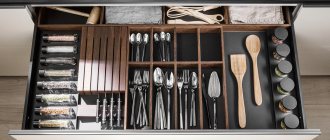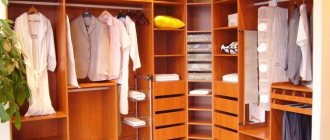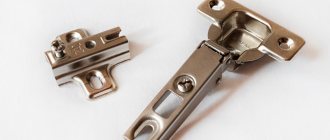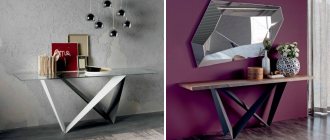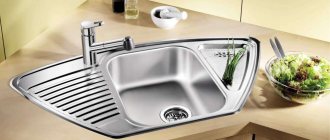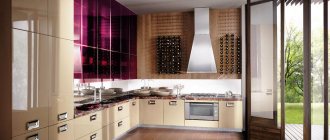Every housewife can create a cozy atmosphere during a meal. Serving is a simple science; it is enough to know the basic rules of etiquette. Any dish will seem tastier at an elegantly decorated table.
Since ancient times, celebrations have been accompanied by feasts, and it was then that customs and rules for table setting began to take shape.
Why is table setting necessary?
For some reason, it is generally accepted that it is necessary to set the table correctly only in a restaurant. Nothing like this! Serving is a sign of respect for guests, a sign of the good taste of the owners of the house. It will be useful for everyone to know how to properly place cutlery on the table. You need to be able to create a festive atmosphere at breakfast, lunch, and dinner.
Many table settings, shown in films and TV series or described in books, are frightening because of their complexity.
By the way! Scientists have proven that the production of the joy hormone during eating improves metabolic processes in the body and promotes the absorption of nutrients.
Peculiarities
Each restaurant has its own characteristics. By them, people are accustomed to mean a special menu, an expensive interior, and some kind of evening program, music, for example. For some visitors, the peculiarity of the establishment lies in its name.
In fact, the features of a real status and attractive restaurant lie in ordinary little things. These include tablecloths, wine glasses, cutlery, napkins, vessels with flowers, plates, candlesticks, and other attributes. All of them are components of the serving process in a restaurant complex.
There are two ways of serving - preliminary and executive (main).
The executive method is used with a predetermined menu. It is used at banquets and other festive events, where everything is discussed in detail in advance. And pre-serving is the preparatory procedure of the hall for the upcoming festive event.
Types of cutlery
Over the course of human history, many food devices have been created. In the process of evolution they underwent changes. Now in the arsenal of many housewives there are sets of cutlery for festive serving made of stainless steel, cupronickel, and silver.
The basic rule of table etiquette is “from the edges to the center.”
Spoons
The dining room is the largest in size. Dessert is ¼ less. The tea room is almost half the size of the dining room, but larger than the coffee room. Sour cream is easy to recognize by its round, pot-bellied shape. For sugar, it is made in the form of a scoop or with a curly ornate handle so that it can be immediately recognized among other spoons.
There may be a lot of cutlery on a set table, but not all of them are there at once.
Important! There are spoons for fruit compotes; they have an elongated handle, instead of the usual spatula there is a scoop for scooping out fruit. Externally, the fruit spoon resembles a miniature ladle. Another wonder is a spoon with an elongated handle for preparing mixed drinks.
Forks
Standard forks with long tines are used for appetizers and main meat courses. A fish fork has shorter teeth to make it easier to remove the bones. Sometimes a fish fork makes a depression in the center. Dessert ones differ in size, the cocotte one has only three teeth, the lemon one has only two.
Today, there are a lot of different cutlery designed strictly for a specific type of dish.
Knives
For appetizers, main courses, and desserts, they always come with a fork. The meat knife should be sharp or have fine serrations, resembling a file. Fishy is more rounded, blunt. The cheese is of medium width with a forked tip; for butter it is wide and blunt. The steak knife is shaped like a small kitchen knife, it has a sickle-shaped blade and a massive handle. The fruit knife is small, the blade is sharpened on both sides, more like a miniature cake spatula with a sharp tip.
The set of knives depends on what dishes will be served on the table.
Forceps
To set the dessert table, use baking tongs; they are convenient for gripping cakes and cake pieces. It is customary to serve cane sugar (it is always in the form of cubes) with small tweezers. They are placed in a sugar bowl or on a tablecloth nearby. There are also tongs for lobsters and snails; they are used to split the shell.
The very name of such tableware will tell the owners which tongs to put next to the salad bowl or in a bucket of ice.
By the way, for serving salads it is convenient to use tongs, which have a spoon on one side and a fork on the other. They are convenient for grabbing the required portion of greens or stringing large pieces of vegetables or fruits.
Other cutlery
A cake spatula is appropriate on the dessert table. For caviar you need a small flat spatula. For game you need special scissors, shaped like pruning shears. Chopsticks are only acceptable on a table decorated in an oriental style when guests are offered Chinese dishes.
Serving a sweet table requires the presence of these devices.
Tip #2: Use serving napkins
Tip No. 2. Use serving napkins
Serving napkins under plates and cutlery will perfectly help keep the tablecloth clean and emphasize the style of the selected dishes. Rough linen or cotton napkins will look best on a tablecloth rather than plastic or wooden coasters. Their color should match (but not necessarily be identical) with the dishes and other table decoration elements, including textile and paper napkins. For example, emerald or deep blue goes well with dishes of a rich light green color, and both beige and purple napkins will harmonize with the coral color of the plates. Don’t forget about the decor of fabric hand napkins. They can be tied with a thin ribbon or even twine with pre-strung beads or flower buds, or you can use original decorative rings.
Rules for serving cutlery
Immutable rules of serving: cleanliness and neatness. Each cutlery made of non-ferrous metals is polished to a shine on the eve of the celebration. The tablecloth is bleached, starched for rigidity, and ironed.
A classic and win-win option is a snow-white tablecloth. She always looks elegant and solemn.
The dishes are arranged so that there is enough space for cutlery. How many dishes there are so many spoons and forks.
The minimum distance between them is 1 cm.
Choosing a tablecloth for the table
At special events, a light tablecloth made of natural fabrics: linen or cotton is recommended. The tablecloth should cover the entire tabletop and hang down to the sides by 20–30 cm.
The tablecloth should be combined with curtains and upholstery.
Important! Stains from starched fabric are easier to remove; they are not absorbed into the fibers and remain in grains of starch, which are easily washed out of the fabric.
Serving plate
The lower large plate is placed 5–7 from the edge, dishes for main courses are placed on top, and a snack bar is placed even higher. A deep bowl for soup is placed on it. Broths are served in special deep cups. The pie plate is placed on the left, away from the edge, the tea cup and saucer is placed on the right, at a distance of 3 cm from the dessert knife. Plates on the table play a key role; they are the basis of serving.
It is the responsibility of the housewife to promptly replace the plates with clean ones.
Arrangement of spoon, fork and knife
Knives are placed to the right of the plates, blade to the edge, forks to the left. The number of forks must correspond to the number of knives. Place the soup spoon next to the outermost knife. Cutlery for those dishes that are served earlier is placed closer to the edge of the plate, the rest are nearby, taking into account the order in which the food is served. With an extensive menu, which includes meat and fish appetizers or a main dish, first put a knife for meat, then for fish. The location of the teaspoon and coffee spoon is the same, on a saucer; a knife for butter or cutting pies is on a pie plate.
According to the rules of etiquette, the spoon and knife should be placed to the right of the plate, and the fork to the left.
Where to put the napkin
Large decorative napkins are laid out under a large plate. The woven lip wiper is installed or laid out on the top plate. If the napkin is rolled into a tube or shaped into a ring, it is better to place it next to the forks, closer to the plate.
Napkins can be any color, the main thing is that they are folded beautifully and neatly.
Drinkware
Glasses, wine glasses, glasses for wine, juices and drinks, shot glasses are placed to the right of the plates, away from the edge, aligned in height, from right to left.
They can be made from either glass or crystal.
Glass and crystal dishes
You need to place the same number of glasses on the table as the number of drinks that are supposed to be served during the meal. The classic version includes glasses for white and red wine and a glass for water.
When serving, the waiter will independently fill the required glassware with the appropriate drink.
Glassware for serving the table is placed to the right of the main plate in a straight line or in an arc. If there are more than three glasses, then they are placed in two rows so that the large ones do not cover the small ones.
The stronger the drink, the smaller the size of the container intended for it.
Types of table settings
Each type of meal requires a special atmosphere. An ordinary lunch, of course, differs from a festive dinner. When only dessert is served, the table should not appear empty.
Descriptions of several classic options for a set table will help awaken your imagination.
Table setting for breakfast
An individual decorative napkin is placed for each family member. Place a snack plate in the center and put cutlery. On the left is a place for a pie plate. Nearby is a glass for juice or water. A coffee or tea pair with a spoon is located on the right.
Vases with flowers, napkins and cutlery with spices are usually placed in the center of the table.
For a shared breakfast, it is acceptable to serve sliced bread in a nice small bread bowl and butter in a butter dish. Sliced meats are laid out in an elongated dish, the cheese is usually not cut, served in one piece on a flat plate or serving board, each cut as much as needed for breakfast. Paper napkins are placed in a napkin holder next to the spice set.
Bread can be served in a wicker basket, and butter can be served in a butter dish made of ceramic or porcelain.
Dinner and supper
Lunch involves frequent changes of dishes; the dishes are arranged so that everyone sitting at the table can be approached from the left side. After arranging the cutlery, choose a place for the tureen; place a ladle next to it on a ceramic stand so that there are no stains on the tablecloth. Shared hot dishes are laid out so that everyone can reach the plate independently; usually 4 servings are placed on a common plate. Slices and appetizers are designed for 6 people or arranged individually for each person.
The dinner table is set in such a way that guests can be served conveniently and quickly.
Proper table setting for dessert
The service will make the dessert table elegant and sophisticated. It’s beautiful when there is a teapot, candy bowls, a sugar bowl, and croutons with cookies in the same style on the table.
A dessert plate is placed in front of each person, next to a couple for a hot drink. Appropriate:
- wine glasses;
- juice glasses;
- glasses for water.
The ideal option would be to use a special service.
Bowls for jam and preserves are placed next to the dessert plate on the right, away from the edge of the table. It is better to buy lace napkins. The tea bags are placed in baskets or on saucers, the coffee is placed in jars, and a long-handled spoon is placed on top. Boiling water is best served in a large porcelain teapot. Lemon slices are laid out on a special tray.
Serving for the holiday
The festive table is distinguished from lunch or dinner by high-quality tableware and elegant salad bowls. The permissible minimum distance between chairs is 50 cm. If it is double hot, add additional cutlery.
Banquet table setting helps create a festive mood.
Children's table
For children's matinees, a bright colored tablecloth is acceptable; it may not cover the entire table; it is often laid diagonally so that children do not move the fabric at the corners. The number of plates is limited; a diner is enough. There is a minimum of salads, the emphasis is on portioned dishes that do not need to be cut. They are placed in front of everyone individually in bowls or on saucers.
The tablecloth should be light shades.
By the way, fruit salad can be served in orange halves, after removing the core.
Is color important?
Color is always important, and their harmonious combination will help in design. A white tablecloth is a tribute to tradition; it matches almost all colors of dishes. Variegated dishes look advantageous on a plain tablecloth, but for a plain set, you can equally choose both tablecloth options. Napkins should be in harmony with the tablecloth.
It may seem that a black and white table setting is something out of scope, but it is not. The harmonious combination of these two colors can add special charisma to the reception.
The combination of purple and mint (green) looks very fresh, the red color adds solemnity. Silver and gold are integral attributes of a wedding. A dinner in honor of a man must be laconic, with white dishes and contrasting napkins. Bright colors are the right solution for a bachelorette party.
The Importance of Choosing the Right Table Color Scheme
When setting a table, the tablecloth is chosen according to the type of event. For everyday use, variegated or plain fabric with acrylic coating is allowed, the main thing is that it matches the colors of the dishes.
Shades of red stimulate the appetite, while cool blue tones pacify it. Yellow and orange create a good mood, green have a calming effect.
The principle of arrangement of cutlery: the dish that is served first is the farthest cutlery.
It is better to decorate a romantic dinner in dark colors so that burning candles look advantageous. There is no need for unnecessary details on the table that interfere with communication: vases with flowers, multi-tiered fruit stands.
A formal event requires moderate, muted tones and crystal tableware. Themed parties will be memorable if the tablecloth contrasts with the colors of the dishes.
Setting a holiday table is also an opportunity to show your creativity.
Stylish examples and options
Each person will be able to create a table setting to their own taste, regardless of what kind of dishes they use: ceramic, glass or stainless steel. Let's look at the most interesting table decorating techniques.
Classic always remains relevant in table design and serving: dishes of neutral colors with patterns made in gold or silver shades are used. They will be in harmony with the color of the cutlery: this will create a unified image on the festive table.
- You can use dishes of unusual bright colors. Rich colors that contrast sharply with tablecloths or main courses are a fashionable design trend that has become increasingly popular lately.
- This also includes the unusual texture of the dishes: some plates may have a three-dimensional pattern and ornament. They will add zest to the holiday table.
To learn how to properly set the table, watch the following video.
Additional decorations for serving
The decor should not be conspicuous; it complements the serving of dishes. Inappropriate:
- high compositions;
- vases with huge bouquets blocking the view;
- strong-smelling bouquets; guests may be allergic to them.
Decorate with napkin holders and candlesticks. Originally folded fabric napkins are an ideal option for decorating a formal table. Flowers from vegetables and fruits, edible compositions are appropriate for any dinner, they have a place on the dessert table.
A win-win option is to use flowers. Usually they are placed in the middle of the table - it can be a bouquet or composition.
Knowing the secrets of serving, you can turn a traditional meal into a wonderful meal, where everyone will enjoy not only the food, but also the contemplation of the feast. It's so easy to give joy to your loved ones! Make every family lunch and dinner special.
How to order an office door
You receive expert advice. During the consultation, the manager will help you choose an individual design, door design and components, and tell you about various nuances and electronic security features.
Measurement, conclusion of a contract and prepayment. The master appraiser will make a free measurement of the doorway. The extent to which the new door will please you and perform its functions depends on how accurate and high-quality the measurement is.
Door production and status tracking As soon as you have concluded a contract and made an advance payment, agreed on all dates and deadlines, the order goes into production. Door production usually takes from 3 to 14 working days after the conclusion of the contract.
Door installation and full payment Our company has a special approach to door installation. Each installation service employee undergoes mandatory training and annual certification. And the total experience of each team is at least 500 installed doors.
How to do it?
The word “setting” is translated as preparing the table for dishes, when all the dishes are placed in a certain order. In a restaurant, when serving, you need to adhere to the correct order:
- The very first thing is to cover the table with a tablecloth. This is delicate work, you need to do it so that the tablecloth does not wrinkle.
- Next, porcelain or earthenware dishes (various shapes and sizes of plates) are displayed.
- There is a queue for the devices. These are forks, spoons, knives and accessories, this is related to the menu.
- Next, crystal or glass is placed. Wine glasses, glasses and glasses should be presented correctly - holding them by the stem. The number of glasses on the table depends on what alcoholic drinks will be served during the feast.
- It's time for the napkins.
- Next comes the arrangement of spice utensils, various candelabra and flower vessels.
An integral component of serving is a fabric napkin. It is folded to match the purpose of serving. For a banquet, for a festive feast, it takes on a cone-shaped shape. There are other options for laying out napkins.
Setting the table does not have to be in a classic style. Sometimes you need to give free rein to your imagination and dreams. There is a French style, and Ukrainian, and Russian, but the thematic component must be present and coincide with both the interior style of the hall and the rest of the common areas (for example, a terrace). Proper serving is a whole science, the goal of which is to arrange the cutlery in such a way that it is convenient for guests. All standards must also be met.
To the professional restaurant service and interior of the establishment, you can add a waiter, who should effectively fit into the complete picture.
Auxiliary accessories
If we continue the theme of tea drinking, it is worth mentioning everything necessary for serving the cake. If tea drinking ends a dinner party, then all the dishes are first removed from the table. Dessert cutlery is placed in its place. The cake is brought out on a tray or vase on a leg. The vase can be with or without sides. The dish, as already mentioned, is pre-cut into portions. The only exception is a wedding, where the newlyweds cut the cake in the presence of guests.
Use a pastry spatula to place dessert on plates. Although it belongs to the auxiliary accessories, it is not at all secondary on the festive table. It’s good if the spatula is in tune with the rest of the cutlery. It can be combined stylistically with a vase or with cups and saucers. And although cakes with a soft base can be eaten with either a dessert spoon or a fork, the second option is still more convenient.
The list of serving accessories can be short, or it can be long - depending on what goals the owners are pursuing and what level of reception they are organizing. Restaurants must use all utensils required by etiquette. At home, the system is simplified.
Auxiliary accessories by type of device.
- Spoons. In addition to the main spoons, you can stock up on a scoop spoon for sauces and a scoop spoon for granulated sugar. This also includes a caviar spatula and an ice cream spoon.
- Forks. Serving a special herring fork with two prongs, as well as a salad fork with three prongs, will be effective. You can also stock up on a julienne cocotte fork - it is very elegant.
- Knives. In addition to the basic ones, you can expand your arsenal of cutlery with a knife for butter, cheese and berries and fruits.
- Forceps. In addition to the tongs already mentioned above, you can get tongs for ice, green beans and lobster.
Of course, many people start learning table etiquette from the plates. If you are sure that you already have different types of them, check to see if the menu plate, egg plate, rosette and bowl are included in this list. Perhaps there is still some work to be done.
Examples of proper serving are numerous thematic photos. Observe how the experts handle the table setting, what design the cutlery can be, and how they look on the common table.
To learn how to use cutlery correctly, watch the following video.
